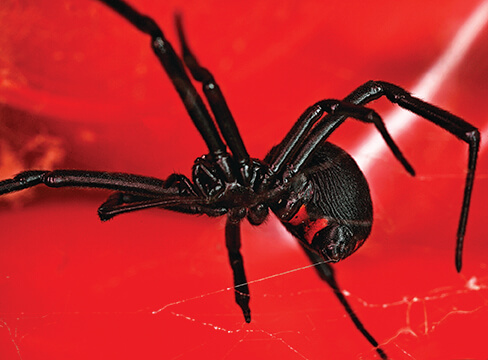The black widow spiders or the Latrodectus mactans are dangerous, poisonous, and deadly. But, did you know black widows have not-as-poisonous twins? Yes! You read that right. Their doppelgangers are called false widow spiders. This makes it difficult to identify the real black widow spider, and after knowing about the threat of a black widow, can we risk treating a similar-looking spider as a false widow? No way!
So, if you:
- are suspicious of a spider that looks like a black widow;
- want to understand the difference between a black widow and other species;
- just stumbled upon this article;
Then keep scrolling!
This blog will learn more about black widow spiders so that you can stay away from them.
Let’s go!
What are black widow spiders?
Black widow spiders are named so because it is believed that the female spiders consume their male partner after mating. The black widow species can be found across the globe. But the top five black widow species are prevalent in the United States. It takes nearly a year for most black widows to grow from an egg to an adult. Black widows prefer dark and dry locations to make their webs, which are irregular in structure. It is always found near ground level.
Identification of Black Widow Spiders
The most distinguishing feature that separates black widow from a false widow and other species is their reddish-orange hourglass marking on their abdomen. Black widows exhibit a shiny black appearance and are round-shaped. Occasionally, the female spiders can be brownish-black in color. While the average size of black widows is 3 to 10 mm long, the females can be larger than the male spiders.
Where are black widow spiders found?
Black widows mostly live outdoors, in protected areas, such as outbuildings, shrubs, under stones, woodpiles, decks, and hollow tree stumps. Inside premises, they can be found in yards and dry man-made structures like barns, henhouses, outhouses, barrels, brick veneers, sheds, and meter boxes. If they get an opportunity to slip indoors, black widow spiders will hide in dimly lit, quiet, and sheltered locations like basements, garages, under furniture, and crawl spaces.
Are black widow spiders dangerous?
Black widow spiders are one of the most venomous spiders found in the United States. Their venom is said to be 15 times stronger than the venom of a rattlesnake, which is enough to send anyone to the hospital if immediate medical attention is not given.
Some symptoms after being bitten by a black widow spider include:
- Tremors
- Sweating
- Abdominal pain
- Muscle stiffness
- Headaches
- Nausea
How to keep black widow spiders away?
- Stack woodpiles 20 feet away from your property.
- Trim down the overgrown trees and remove tall grass and weeds from the exterior walls.
- Mow the grass short and keep your lawn well-maintained.
- Ensure that doors and windows of your garages, sheds, and other outbuildings are closed tightly.
- Replace cardboard storage boxes with plastic containers with locking lids.
- Avoid clutter and keep your storage areas neat and organized.
- Always wear gloves when you work outside for your protection.
- Seal their entryways by repairing cracks, seal the gaps and spaces around the utilities that enter your home, and other openings in the foundation and exterior walls of your home.
Wrapping Up
Black widow spiders are dangerous and can cause harm if they bite you. If you spot messy, irregular-shaped web in your house, be sure that a black widow is hiding in your house. Don’t take the risk of removing them all by yourself. Stay alert and seek the help of pest control professionals who are trained to get rid of any deadly pests with utmost care.







